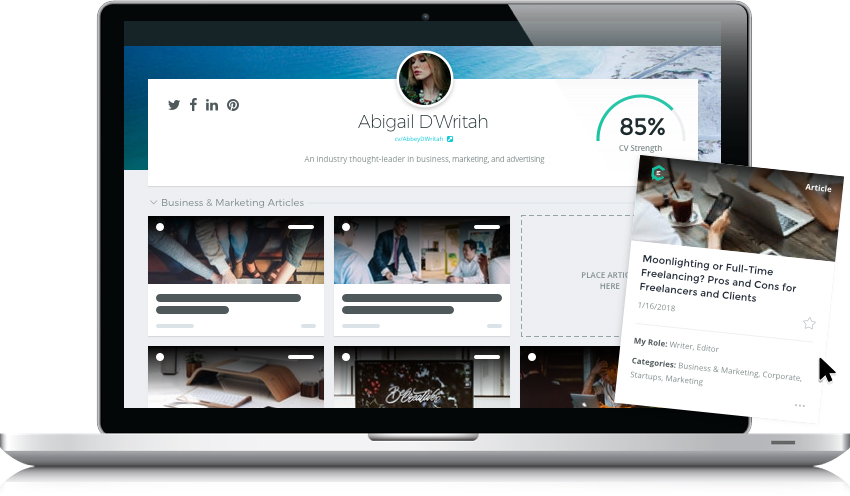In a rather startling statistic, digital media experts now estimate that the average wired and tired American sees anywhere from 4,000 to 10,000 ads per day. This means that between your morning crawl to the Keurig dispenser and your nighttime slog through Instagram, you’ve been exposed to thousands of messages vying for your most precious top-of-mind real estate.
I only mention it because so are the people you’re hoping will find — and marvel at — that beautiful portfolio you just perfected with a compelling personal bio, relevant work samples, and tight descriptions that speak to your various roles/abilities. So instead of letting America sink down collective rabbit holes filled with pre-roll, interruptive imagery and stories about how fabric softeners can change their lives, why not let them spend time obsessed with how you, trusty freelancer, can do that instead?
Sorry Snuggle bear. You can take that sheet and shove it.
But here’s the thing.
Artists and creators traditionally suck at the art of self-promotion. And who can blame them? We’d rather spend our time producing the work versus promoting it. That said, we can’t just put our trust in the work world to find our stuff based solely on word of mouth and the mystical energy we put out into the universe. We have to be smart about it. Strategic. Tactical. To up the odds.
It’s time to take the power out of the hands of distraction and turn it into action. Here are five ways you can get people to find your portfolio online so you can go about doing the things that make owning your own freelance business worthwhile.
Like doing the actual work!
Step #1: Up your SEO game
No matter where your portfolio lives, one of the best ways to drive traffic to it is by optimizing the portfolio’s content via SEO. On that note, it’s worth knowing how to populate the pages where your portfolio lives with the right keywords, headings and titles that get crawled by search engines — all factors that affect page rank. Even tagging images with the right keywords is huge, as it will help you get found through increasingly popular image searches, especially important if you’re a graphic designer or art director.
One of the best parts about creating a free online portfolio with ClearVoice is that they’ve already built a template that’s easy to populate and optimize in many SEO-friendly ways already by including sections for primary role, content type and descriptions. The content is also organized really well and automatically reduces image sizes to minimize page-load times (a consideration for Google page rank factor) to make the experience of reviewing your work seamless and organized, top to bottom. The subheads and description fields also allow you to write about each project using keywords and phrases to get found by search engines.
Some of the phrases I chose carefully for my portfolio were roles I’ve held and hope to get found for via keyword searches, on ClearVoice and off. These words and phrases include “agency-tested copywriter,” “branded editorial” and “content creator.” I also tossed in a random fact about once losing a game of HORSE to the shortest NBA player of all-time (Tyrone “Muggsy” Bogues). But that was mostly to stand out since I might be the only person to ever so publicly lose a game of HORSE to him on the record.
By checking all these boxes, the thought is that I will benefit from ClearVoice’s “robust algorithm” used to crawl CVs and find freelancers qualified to match up with prospective clients who may be evaluating talent using their network. And since I have a breadth of content examples (50+) that populate my profile, I’m also positively influencing my SEO page-rank off-site so that my portfolio can be found through the side door via SERPs (search engine results pages) on sites like Google.
Step #2: Put your byline out into the world.
In the year 2018, there are so many “experts.” Throw a rock and you’ll hit 100 of them on LinkedIn. It’s one of the most overused resume terms these days next to “seasoned” and “best-of-breed.” But that doesn’t mean you shouldn’t become an expert of sorts at putting your byline — along with a link to your portfolio — into the world on sites where you can receive qualified eyeballs.
Let me explain.
As a freelancer with a portfolio online, you’ve most likely worked for clients in several capacities. Maybe you’ve become an ace at designing eBook covers; a master at social media; or developed a profound understanding for what comprises an effective lead. Whatever your jam is, the chances are you have something to say on the topic, so say it for whomever will have you. In this regard, LinkedIn is huge because it allows its users to produce and publish thought leadership pieces across its platform — for free. That’s something Medium does as well, a publishing platform that believes in “feeding minds, not mindless feeds,” but for a small fee.
Another smart way to lead is to plant seeds for future traffic by curating content other people have produced via posts on LinkedIn or other forums where your prospects hang. On LinkedIn, this qualifies as “activity” and if you do it right, can be just as powerful as a column, blog post or thought leadership piece at keeping people in tune with your voice and professional POV. On that note, guest blogging is also solid way to put your brand out there and boost your hiring appeal/ranking on search engines.
No matter which of the above approaches you choose, just make sure you have a link to your portfolio nearby, either in your bio blurb or as an actual link embedded in the actual piece. If what you have to say resonates, the quality leads will eventually come.
Step #3: Embrace the power of a well-composed email.
Reports of email’s death have been greatly exaggerated. No matter how many push notifications and social media posts we read, recent studies indicate that our obsession over email is as strong as ever, as we apparently check our email roughly 200 times a day for 2.5 hours (depending on your position and willpower). That’s why if you channel email’s powers for good, putting your latest portfolio pieces into a targeted email message, it can work wonders if you have a captive audience who cares about you.
Think about it.
People like to hear from people they know. And given your work history and ever-growing network of colleagues and collaborators, a well-composed email spotlighting the latest work you’ve put out into the world can win you some portfolio views and undivided attention in a world of perpetually divided attention. And before you say, “that’s what social media is for,” I challenge you to do an honest inventory of how many social media posts you see versus click on. I’m guessing it’s way less than 1%.
That’s why an email from a prospect can increase those odds as long as it includes the following:
Quick loading times: Remember why dial up and the buffering color wheel that have come to symbolize all things we hate with a passion and secretly want to mutilate? Yes? Well that’s why you need to watch the heft of the images you implant in your email body to make sure the size of what you send complies with the best practices of the email client you’re using.
A catchy subject line: Think different. When others zig, you zag. Find a hook. Capture people’s attention and give them a reason to check in with what you’re doing. The best email subject lines I’ve ever seen stand out from the rest and make people smile or laugh or take notice because they include a unique twist on a conventional approach.
A few examples that come to mind include:
- My Latest Work Is So Good You Can’t Unsee It
- Do Not Open Unless You Want to See a Real Life Unicorn
- See What Donald Trump Tweeted About My Work
Maybe forget that last one, but I think you get the picture.
Intuitive Design: The eye likes to scan and people don’t like to read anymore, unless they have to. In an email, this logic holds true times ten. Remember your goal isn’t to have people stop at your email, but click through to your online portfolio. So, in that vein, give them a couple of enticing pictures, a compelling case study and a reason why the HAVE TO see what you’ve been up to.
And then, convert their click.
Step #4: Make your portfolio just one part of your “freelance business.”
An online portfolio isn’t a sales pitch in and of itself. It’s a great way to show your work, but there may be other considerations a company or prospective hiring manager may want to see before recruiting your services. In that regard, using your online portfolio as one piece of a bigger website story could well position you as a more than just a gun for hire. If you go that route, paying to promote your portfolio (once it’s pristine and positions you correctly) isn’t the worst idea given the state of targeted and behavioral advertising, smart keywords and optimized searches. A paid promotion strategy — if strategized correctly — could benefit your bigger entrepreneurial thinking depending on how big you want to go with your freelance business.
I can’t tell you how many times I’ve sought out services on Google without knowing who I was looking for and ended venturing no further than page one of Google’s search results. It may sound counterintuitive since you want to be found based on the merits of your work, but I’d remiss if I didn’t mention that it could open doors you may not realize even exist. And the results could pay for themselves rather quickly. That is, you may spend $500 on advertising to try and drum up a few quality leads, but if you land just one client from this paid advertising strategy, the chances are better than good that it will pay for itself on job number one or two.
Who knows, might be worth a test.
Step #5: It might sound obvious, but… producing quality work… never a bad idea.
We just reviewed several of the creative ways you can drive traffic, but it should be said that the first and best way to drive eyeballs to your portfolio is by doing great work. Cream rises to the top. And though it may sound obvious, there’s no replacement for putting the lion’s share of your sweat into doing the kind of work that makes clients smile and send your portfolio along to their friends. Be it a print ad, a branded video or a passion project you whipped up on spec, let quality control rule the day. It gets people pumped to spent time with your work and puts your name at the top of their freelancer to-do list.
In that regard, I leave you with this nugget from Srinivas Rao, author, speaker and Chief Creative Instigator of Unmistakable Creative, who has written extensively on the topic of creativity and how to nurture it. His advice also happens to be a great philosophy for how to write, connect with people, and peddle your brand across the digital universe to drive portfolio clicks:
One of the great paradoxes of creative work is that what we create for an audience of one is much more likely to reach an audience of millions. When we sanitize and optimize our work in the hopes of driving eyeballs and clicks, the work loses its authenticity and potential resonance… When we create for an audience of one, our work is no longer dictated by the opinions of an audience. Instead, we’re driven by a love for the work itself. We create what we want to see exist in the world and make art that we’re proud to put our signature on. — Srinivas Rao
Makes sense, right? As you work through the tips above, consider that what you put out there will in large part dictate the clients you will attract… so, spend the right amount of time making sure your portfolio shines before deciding how to make it seen.
That’s the way to go if you truly want to grow.
Create a beautiful portfolio to win over new clients
Showcase your work with a free CV Portfolio designed for freelancers, by freelancers. No hurdles, no charge, no hassle. Claim yours now!







